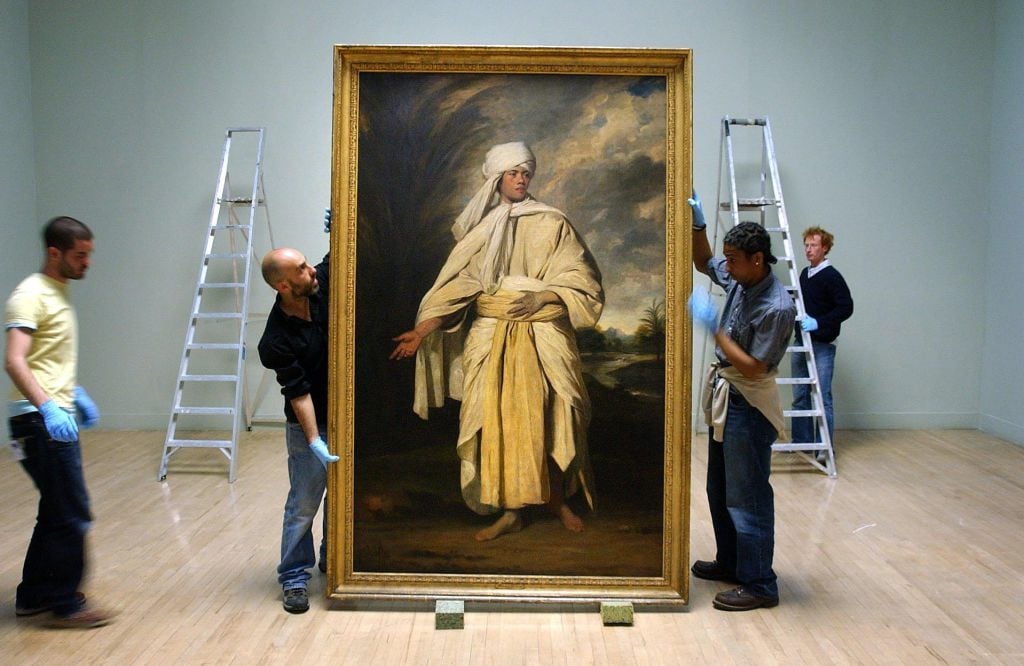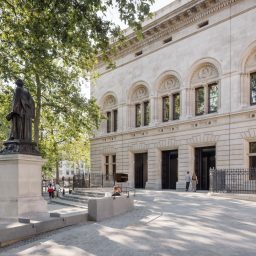For months, the National Portrait Gallery in London raced to raise enough funds to purchase Sir Joshua Reynolds’s 1776 painting Portrait of Mai. The goal was to keep the historically significant artwork, which depicts one of the first Polynesians ever to visit Britain, in the country.
Today, the museum has found a way to acquire the painting—but only under the condition that it is regularly sent to the U.S.
The National Portrait Gallery has teamed up with the J. Paul Getty Museum in Los Angeles to jointly purchase Reynolds’s masterpiece, the two institutions announced today. They will effectively share the artwork, with each expected to pay half of its estimated £50 million ($62 million) price tag.
The unusual agreement marks the first time ever that museums in the U.K. and U.S. have partnered on a single acquisition.
In a statement, Katherine Fleming, CEO of the J. Paul Getty Trust, which oversees the museum, called the agreement an “innovative approach to ownership… that maximizes accessibility and viewability while placing Portrait of Mai in a rich and multifaceted transatlantic context.”
Completed nearly 250 years ago, Reynolds’s painting portrays Mai (also known as Omai), a young Tahitian man who sailed from his home country to England in 1774 with the British explorer James Cook. It was created for “personal reasons,” rather than on commission, and remained in the artist’s studio until he died in 1792.
“The portrait is unique in both British and world culture and yet has never been in a museum collection. Now it has the potential to be in two, one facing the Pacific from where Mai came, and the other only yards from Reynolds’s studio, where it was painted,” said National Portrait Gallery director Nicholas Cullinan in a statement.
“For the gallery, it is important that this outstanding portrait is for the U.K. public, and we will share it with other institutions across the country,” Cullinan continued. “This is a painting that should belong to all of us and we know it will mean a great deal to our combined audiences, locally, nationally and globally.”
Following Reynolds’s death, Portrait of Mai was acquired by Frederick Howard, 5th Earl of Carlisle. It remained with Howard’s estate all the way until 2001, at which time the Dublin-based businessman and collector John Magnier purchased it at a Sotheby’s auction for £10.3 million ($12.4 million).
The artwork was valued at £50 million ($60 million) last year, when Magnier applied for an export license to transport it abroad.
In an effort to give institutions in Britain an opportunity to purchase the prized painting, the U.K. arts minister placed a temporary export ban on it. The ban’s expiration date has since been extended three times—including, most recently, earlier this month, when the deadline was moved to June 10.
The National Portrait Gallery initially intended to buy Portrait of Mai singlehandedly, and it launched an ambitious fundraising campaign to do so. The U.K. nonprofit Art Fund donated £2.5 million ($3 million)—the largest such grant in its history—and the National Heritage Memorial Fund pledged an additional £10 million ($12 million). Meanwhile, an additional 1,500 people contributed to an open call for donations.
Still, as of March 10—the last day of the export ban, before its expiration date was again extended—the National Portrait Gallery had raised less than half of the £50 million needed for the purchase.
In stepped the Getty Trust, a private body, which plans to match the National Portrait Gallery’s contribution. However, the acquisition has not been finalized yet, and the latter museum still has under £1 million ($1.2 million) left to raise.
If the deal does indeed go through, the two institutions will periodically send Portrait of Mai back and forth, and neither will charge money for visitors to see it. The painting is expected to be on view at the Getty in 2028, when Los Angeles hosts the Olympic Games.
“The complex artistic and historical issues that this painting raises will form the basis for a joint research initiative on 18th-century British portraiture involving exhibitions, conferences, and technical investigations,” added Timothy Potts, director of the J. Paul Getty Museum. “We hope very much that this acquisition and the collaborations that flow from it will inspire other innovative models of collecting, sharing, and protecting artistic heritage across nations, cultures, and peoples.”









